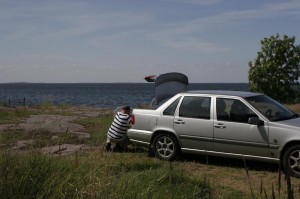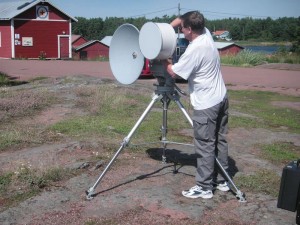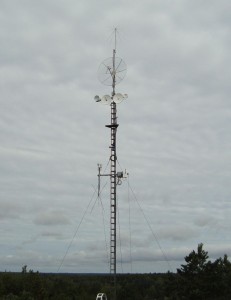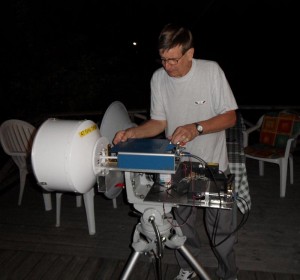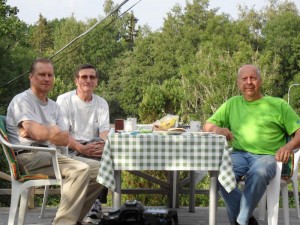First 47GHz SM-OH
SM0DFP 2011-Aug-10
First QSO between Sweden and Åland/Finland on 24GHz and 47GHz.
OH2AXH Pertti and OH6DD Jukka
asked if there was any interest to attempt a 47GHz QSO between Aland and
Sweden. We decided to make a test in August 5-6-7. As Pertti had his 24GHz portable rig on loan to SM0ERR Mart, so SM0RPT Johan, went with the ferry from Grisslehamn to Eckerö, carrying the 24GHz part of the SK0CT rover with him, thus making it possible to also work a first on 24 GHz.
The path between JP90JC, Grisslehamn and JP90SF on Eckerö/Åland is 44km with only some low rocky islands in the LOS (Line Of Sight).
SM0RPT is preparing the 24GHz equipment. The picture show the path from Eckerö, Åland JP90SF toward JP90JC.
The first attempt on Friday on 24G was easy with very high signal strength.
47GHz part of the test.
Pertti had made a 47GHz station
that is capable to deliver 50mW, which is QRO on 47GHz. He has mounted
both 10GHz and 47GHz antennas on the same boom. This make the antenna
alignment easy, as 10G is used for optimizing the antenna the other station.
OH2AXH is setting up his portable station in JP90SF
SM0DFP fixed station has also all microwave antenna arrangement on one boom. Antennas are 24m agl and 40m asl.
SM0DFP fixed antennas for microwave.1.8m dish for 1296, 2320 and 3400MHz, from left 24G, 5G7, 10G, 47G parabolic dishes.
The fixed 47G rig has only
0,25mW output, so Pertti need to be >23dB above the noise at my end
before he can expect to hear my sigs. As a back up, we can use the
SK0CT Rover and go portable to the water front. SK0CT 47G beacon is able
to switch from automatic CW ID to manual key CW, and deliver 20 mW. It
is used as part of the Rover.
We started with my fixed station
doing 10G alignment, it looked very promising with strong signals, so
strong that it caused overload on my SDR-IQ. We had to go QRP to be able
to have usable S-meter indications. When QSY to 47G, nothing was heard.
After some discussions over the phone, we decided that the OH boys
joined Johan with the ferry back to Grisslehamn. Here we could make a
check of the equipment in a controllable environment.
We started the SK0CT 47G beacon,
turning the antenna to the sky to limit the signal strength. And yes, we
could receive the beacon, but Pertti’s rig only produced a 559 signal
whereas my rig received a 599+40 signal. After some fault finding, we
quickly found the culprit, a newly installed 47GHz BP filter that was
not tuned. The tuning screws were lose, indicating that the filer
was never tuned. In spite of several attempts to tune the filter, using the
beacon as a signal source, we gave up and decided to simply remove the
filter. This was easier said than done, it took two hours to remove the
filter as the rig had to be taken apart in order to reach all little
screws that hold the wave guide plumbing in place. After re-assembly of
the rig, it worked much better, both on RX ant TX. The unwanted mirror
frequency was a minor problem at this stage.
OH2AXH
assamble his 47GHz rig after repair.
Pertti and Jukka stayed
overnight at SM0DFPs place. After a quick cup
of coffee in the morning they returned to ≈land with the morning ferry
on Saturday.
Breakfast in
Grisslehamn, from left, OH6DD Jukka, OH2AXH Pertti, and SM0DFP Per.
When in ≈land, they set up the
station and I used my fixed station and we aligned antennas on 10G,
then QSY to 47G, and now I heard some weak sigs. We never got the sigs up
above 5dB over noise. As we must have at least 20dB signal in my end
before any sigs were expected in the OH0 end, so we decided to go for
plan B. i.e. using the SK0CT’s rover and go to the water front, about
800 meters away.
About 40 minutes later we got
usable signals both ways on 47G and could complete a QSO with 559/559.
The distance is 44km, breaking the old SM record of 27km. We were quite
surprised that there was such an improvement in signal strength when at
sea level with antennas.
After the QSO we decided to make
an attempt to extend the distance. Pertti and Jukka had found a good
place in JP90VC at a distance of 55km from JP90JC. We decided that the
best time to try was in the early morning on Sunday. As I had quite
strong wind, nearly making the antenna tripods fall over, I wanted to go
to another place, a bit more sheltered from wind in the Sunday test.
On Sunday morning all looked ok
when again aligning antennas, and we moved from 10G to 47G, we were very
surprised that the signals were nearly equal in strength. The ERP
difference between the bands is about 30dB. We quickly exchanged 599/599
reports on 47G.
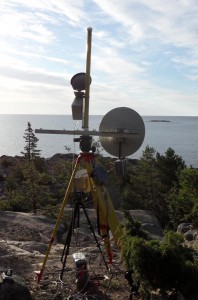
Setup in the SM
end, produced peak 599+40dB signal strength.
The signals were about 599+40dB
when peaking, indicating there is good margin to allow for a much longer
path. We also saw that the antenna direction was uncritical, same
observation in both ends.
Some things worth noting.
1. Antenna is not
necessary producing best signals when placed high. In our case, the
signal strength increased in the order +20dB when lowered from 40m to 5m asl.
2. Once the antennas were in
the duct at sea level, the antenna direction was uncritical. +/- 10
degrees gave no noticeable difference in signal strength.
3. The signal strength was
proportionally better on 47G compared to 10G when antennas were in the
duct.
Extract from the log book:
2011-Aug-05-1252 UTC OH0/OH2AXH
JP90SF – SM0DFP JP90JC 24GHz 59/59 44km
2011-Aug-06 -1314 UTC OH0/OH2AXH JP90SF – SM0DFP JP90JC 47GHz 559/559
44km
Second
attempt to extend the distance on 47GHz
2011-Aug-07-0514
UTC< OH0/OH2AXH JP90VC
– SM0DFP JP90JC 47GHz
599/599 55km
Metrological data
2011-Aug-05-1252 1005hPa,
Humidity 81%, Temp 23C, Wind 5 m/s
2011-Aug-06-1314 1002hPa, Humidity 69%, Temp 24C, Wind 7m/s
2011-Aug-07-0514 1098hPa, Humidity 61%, Temp 19C, Wind 2 m/s
No vertical profile is
available.
Video recordings (a bit shaky)
(c) SK0CT
